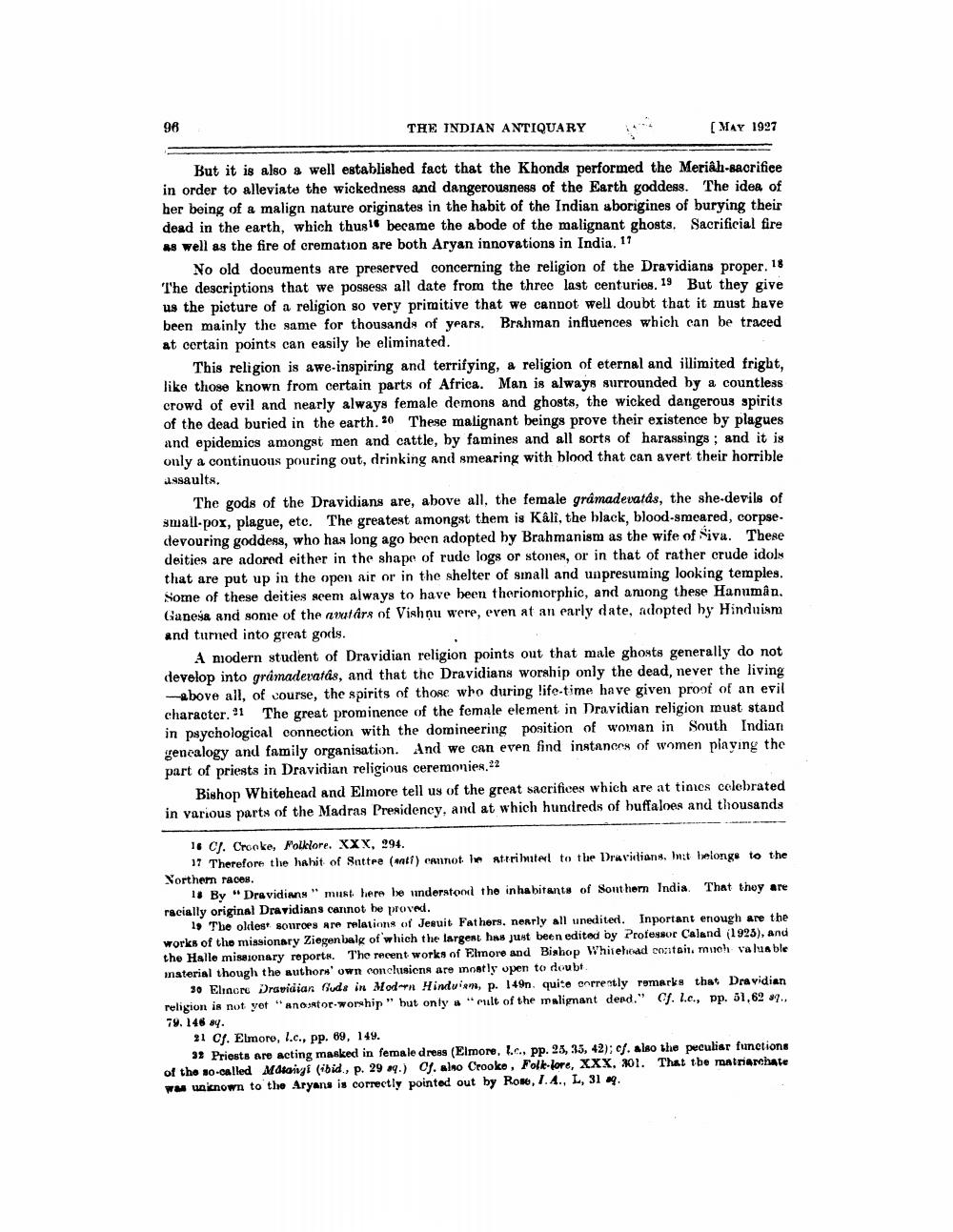________________
96
THE INDIAN ANTIQUARY
(MAY 1997
But it is also a well established fact that the Khonds performed the Meriah-sacrifice in order to alleviate the wickedness and dangerousness of the Earth goddess. The idea of her being of a malign nature originates in the habit of the Indian aborigines of burying their dead in the earth, which thus18 became the abode of the malignant ghosts. Sacrificial fire as well as the fire of cremation are both Aryan innovations in India. 11
No old documents are preserved concerning the religion of the Dravidians proper. 18 The descriptions that we possess all date from the three last centuries. 19 But they give us the picture of a religion so very primitive that we cannot well doubt that it must have been mainly the same for thousands of years. Brahman influences which can be traced at certain points can easily be eliminated.
This religion is awe-inspiring and terrifying, a religion of eternal and illimited fright, like those known from certain parts of Africa. Man is always surrounded by a countless crowd of evil and nearly always female demons and ghosts, the wicked dangerous spirits of the dead buried in the earth. 30 These malignant beings prove their existence by plagues and epidemics amongst men and cattle, by famines and all sorts of harassings, and it is only a continuous pouring out, drinking and smearing with blood that can avert their horrible assaults.
The gods of the Dravidians are, above all, the female gramadevatds, the she devils of small-pox, plague, etc. The greatest amongst them is Kali, the black, blood-smeared, corpsedevouring goddess, who has long ago been adopted by Brahmanism as the wife of Niva. There deities are adored either in the shape of rude logs or stones, or in that of rather crude idols that are put up in the open air or in the shelter of small and unpresuming looking temples. Some of these deities seem always to have been theriomorphic, and among these Hanuman. Ganesa and some of the avatars of Vishnu were, even at an early date, adopted by Hinduism and turned into great gods.
A modern student of Dravidian religion points out that male ghosts generally do not develop into gramadevatás, and that the Dravidians worship only the dead, never the living
-above all, of course, the spirits of those who during life-time have given proof of an evil character. 91 The great prominence of the female element in Dravidian religion must stand in psychological connection with the domineering position of woman in South Indian rencalogy and family organisation. And we can even find instances of women playing the part of priests in Dravidian religious ceremonies.22
Bishop Whitehead and Elmore tell us of the great sacrifices which are at times celebrated in various parts of the Madras Presidency, and at which hundreds of buffaloes and thousands
1. CJ. Crooke, Folklore. XXX, 294.
17 Therefore the habit of Battre (anti) cannot be attri luter to the Dravidians, but belong to the Northem races.
18 By "Dravidians" must here he understooil the inhabitants of Sonthern India. That they are racially original Dravidians cannot be proved.
15 The oldest sources are relations of Jesuit Fathers, nearly all uneditert. Inportant enough are the works of the missionary Ziegen balg of which the largent has just been edited by Professor Caland (1925), and the Halle missionary report. The recent works of Elmore and Bishop Whitehead cositail, much valuable inaterial though the authors' own conclusions are mostly open to doubt
30 Elcro Dravidian Guds in Modern Hinduism, p. 149n. quite enrrently remarks that Dravidian religion is not yet "Anoxtor-worship" but only a "mult of the malignant dead." cf. l.c., pp. 51,62 sq. 79. 146 sy.
21 Cf. Elmoro, l.c., pp. 69, 149.
33 Priosts are acting manked in female dress (Elmore, L.... Pp. 25, 35, 42); cf. also the peculiar functions of the so-called Motaringi (ibid., p. 29 .) Of. alno Crooke, Folklore, XXX, 201. That the matriarchate ww unicnown to the Aryans is correctly pointed out by Rone, L.A., L, 31 .




